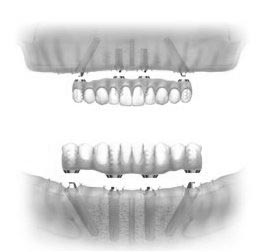Header logo
header top contact widget
Dental Implants
Aging Process For Females Could Up Risk For Gum Disease
Posted on Jul 29, 2015 by William J. Claiborne, DDS MS
As a man, I’ve been made well-aware that menopause is no picnic! From hot flashes to fatigue, night sweats to moodiness, men would be hard-pressed to endure the lengthy menopausal phase.
How does this relate to your oral health? Once post-menopausal, your risk for developing periodontal (gum) disease and experiencing tooth loss increases, particularly in the first decade.
As estrogen levels decline, bone loss increases. Studies now show that bone loss in postmenopausal women can be accompanied by a higher risk of gum disease. One such study determined that post-menopausal women with osteoporosis had a notably higher risk of gum disease than did women with no indications of osteoporosis.
Along with a higher risk of gum disease, post-menopausal women may experience a reduction of saliva, increased dental caries and taste alterations. Estrogen decline after menopause also increases the risk of heart disease, osteoporosis and Alzheimer’s.
For women on hormone replacement therapy (HRT), the restoration of estrogen has been shown to help post-menopausal women be less susceptible to these health issues. This is based on the recommendations of your physician and your receptiveness to using an HRT, of course.
While your oral health is our emphasis, your overall health is also a concern. The two are simply meant to work together. However, it’s natural that adults develop particular risk factors due to the aging process. Our goal is to make recommendations to help you avoid problems in the first place or treat any that arise early to save you time and money.
Begin with a healthy foundation. Call 828-274-9440 for a thorough examination to get your oral health in great shape!
Pace Brushing After Mealtime
Posted on Jul 23, 2015 by William J. Claiborne, DDS MS
In an effort to protect our teeth from accumulating bacteria that causes cavities, bad breath and gum disease, brushing after each meal is wise advice. Right?
Well, right — but there is a proper ‘time delay’ for brushing to avoid damage to tooth enamel. This is because anytime you eat or drink, your mouth endures an ‘acid attack.’ These acids weaken tooth enamel, and brushing too soon can cause damage to the enamel. Naturally, consuming highly-acidic edibles such as tomatoes or orange juice ramp up the acidity level of these attacks.
When eating stops, it takes about 20 minutes for an acid attack to subside. To avoid wearing away tooth enamel, avoid brushing for at least 30 minutes after eating or drinking. If you know you’re going to consume something high in acid ahead of time, brush your teeth first and then swish with water afterwards.
Oral bacteria are able to penetrate a tooth easily without its protective shell of enamel or enamel that is worn thin. This can result in cavities and weakened teeth that can lead to cracks or fractures. If a fractured tooth breaks below the gum line, the only recourse is to remove it. Then, an entirely new set of challenges begin.
Obvious high-acid consumables are citrus, coffee, wine, tomatoes (including sauces and catsup) and colas. However, foods and beverages that may have a higher acid content than you realize include corn, olives, blueberries, dairy products, white rice, white bread, bagels, eggs, peanuts and beer.
Our goal is to help you AVOID problems that could lead to any oral disease as well as tooth loss. Timing your brushing just right can help!
The Challenges Of Dentures
Posted on Jul 16, 2015 by William J. Claiborne, DDS MS
At every age, it is important to stay socially active. Being involved with others is good for our overall well-being as it nurtures our innate need for community. So many social activities seem to include food as the centerpiece. When unstable dentures cause an individual to feel uneasy when eating or speaking, they begin to decline invitations due to fear of embarrassing slips or clicks.
A common complaint of long-time denture wear is the unstable fit. Even though a denture may have fit securely when first made, over time it will begin to move while eating. Biting and chewing contributes to uncomfortable rubbing. Just having nuts or seeds become trapped between the gums and denture can painfully pierce tender gum tissues.
Bone loss causes the fit of the denture to change due to an ever-shrinking jaw bone. This is the result of no longer having natural tooth roots in the jaw bone. Without tooth roots to stimulate the bone, it slowly shrinks, or resorbs.
Denture wearers can actually see the extent of bone resorption by looking in the mirror without their denture in place. They’ll likely see deep wrinkles around the mouth with the corners of their mouth turning downward, even while they smile. Jowls form as facial muscles release from the shrinking jaw. The mouth may appear to collapse into the face with the chin becoming more pointed.
Dentures can also make it difficult to eat a healthy diet. To avoid uncomfortable rubbing on tender gums from denture movement, people tend to transition to a diet of soft foods that dissolve easily with minimal chewing. Unfortunately, these foods lack protein and fiber needed for good health. It is not surprising that denture wearers have higher incidences of gastrointestinal problems and take more medications than non-denture wearers.
To minimize ‘rocky dentures,’ relines may help, temporarily. However, modern dentistry offers a far better option that overcomes all the challenges of living with dentures – Dental Implants. Unfortunately, a denture’s cheaper price tag has kept many people stuck in the a miserable situation.
Dentures simply aren’t a good substitute for natural teeth. Although they may seem better than being without teeth, dentures actually contribute to a number of problems. The pressure of wearing dentures speeds up the rate of bone loss and, for those who sleep in their dentures, the pace of resorption is nearly double.
Dentures are an antiquated solution for tooth replacement. No adhesive or reline will ever make a denture a practical alternative for missing teeth. For today’s active adult, Dental Implants provide a dependable option that restores chewing stability and laughing confidence. And even though the cost is higher, for one’s overall health and well-being, they’re a bargain.
Today’s implant dentistry offers many options. Learn those that are best for your needs and budget in a Consultation appointment. Call (828) 274-9440 to schedule a time.
Why Tooth Loss Causes Your Jaw Bones To Shrink
Posted on Jun 22, 2015 by William J. Claiborne, DDS MS
The presence of natural teeth is vital to the health of upper and lower jaw bones. Tooth roots create stimulation to the bone, which stimulates blood flow so the jaws maintain a healthy mass. Without tooth roots, the lack of stimulation causes the bone to slowly decline. This process is known as “resorption.”
Resorption causes the gum ridge to flatten out over time, giving your denture a foundation that continually shrinks. Regardless of the amount of denture adhesive applied, the denture will begin to move while eating, causing uncomfortable rubbing. Laughing becomes overshadowed by the fear of embarrassing slips.
The pressure from wearing dentures actually accelerates resorption, especially for those who sleep in their dentures. The 24/7 pressure speeds the process of resorption to an even greater degree.
When dentures are first made, they may feel secure for the first five or so years. However, as resorption continues, relines help only on a temporary basis. As bone loss progresses, relines will last at less frequent intervals each time.
On average, denture wearers experience a 25% bone loss one year after natural teeth have been extracted. Three years later, 60% of the bone is gone. While natural teeth provide a biting force of 250 pounds, the average denture wearer bites with about 5 pounds of force.
Want to see the extent of bone loss you’ve experienced? Remove your denture and look in the mirror. Do you see deep wrinkles around the mouth? Do the corners of your mouth turn downward, even when you smile? Does your mouth appear collapsed inward with a pointed chin? Have jowls formed on the sides of your face?
New designs in Dental Implant systems can overcome even severe bone loss. Types like All-On-4 can be placed in minimal bone using just four implants. Using specific angles, the All-On-4 system can support a full denture that is non-removable.
When a greater level of bone mass is necessary, procedures can restore the bone to a healthy level. Bone generating materials or a bone graft can be performed prior to implant placement. A “sinus lift” may be advised so sufficient bone exists between the upper jaw and sinus cavity.
Regardless of the procedure or implant type selected, a dental specialist who is trained and experienced in all implant types is the best choice for a successful result. A Periodontist is a dental specialist with advanced training in the diagnosis and placement of Dental Implants as well as bone rebuilding procedures.
Dental Implants restore chewing comfort and the ability to speak and laugh with confidence. Today, bone loss doesn’t necessarily prevent you from enjoying these benefits! Begin with a consultation by calling (828) 274-9440.
Recent Posts
Categories
Archives
- September 2024
- August 2024
- July 2024
- June 2024
- May 2024
- April 2024
- March 2024
- February 2024
- January 2024
- December 2023
- November 2023
- October 2023
- September 2023
- August 2023
- July 2023
- June 2023
- May 2023
- April 2023
- March 2023
- February 2023
- January 2023
- December 2022
- November 2022
- October 2022
- September 2022
- August 2022
- July 2022
- June 2022
- May 2022
- April 2022
- March 2022
- February 2022
- January 2022
- December 2021
- November 2021
- October 2021
- September 2021
- August 2021
- July 2021
- June 2021
- May 2021
- April 2021
- March 2021
- February 2021
- January 2021
- December 2020
- November 2020
- October 2020
- September 2020
- August 2020
- July 2020
- June 2020
- May 2020
- April 2020
- March 2020
- February 2020
- January 2020
- December 2019
- November 2019
- October 2019
- September 2019
- August 2019
- July 2019
- June 2019
- May 2019
- April 2019
- March 2019
- February 2019
- January 2019
- December 2018
- November 2018
- October 2018
- September 2018
- August 2018
- July 2018
- June 2018
- May 2018
- April 2018
- March 2018
- February 2018
- January 2018
- December 2017
- November 2017
- October 2017
- September 2017
- August 2017
- July 2017
- June 2017
- May 2017
- April 2017
- March 2017
- February 2017
- January 2017
- December 2016
- November 2016
- October 2016
- September 2016
- August 2016
- July 2016
- June 2016
- May 2016
- April 2016
- March 2016
- February 2016
- January 2016
- December 2015
- November 2015
- October 2015
- September 2015
- August 2015
- July 2015
- June 2015
- May 2015
- April 2015
- March 2015
- February 2015
- January 2015
- December 2014
- November 2014
- October 2014
- September 2014
- August 2014
- July 2014
- June 2014
- May 2014
- April 2014
- March 2014
- February 2014
- January 2014
- December 2013
- November 2013
- October 2013
- September 2013
- August 2013
- July 2013
- June 2013
- May 2013
- April 2013
- March 2013
- February 2013
- January 2013
- December 2012
- November 2012
- October 2012
- September 2012
- August 2012
- July 2012
- June 2012




